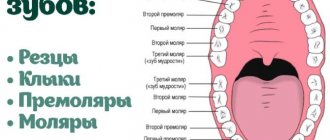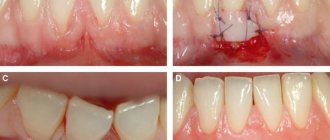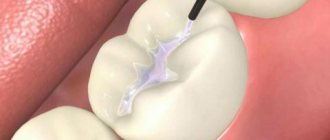Dental sealants or dental sealants are a large group of synthetic plastics based on acrylic acid esters. The use of sealants as a means of caries prevention has become widespread. The method of using a sealant is to hermetically seal the fissures of chewing teeth.
Sealants are considered the only reliable method for the prevention of caries of the grooves of teeth, but the labor intensity of this method implies its infrequent use.
Fissure sealing - dental sealants
The main role in the origin of caries is played by soft plaque, consisting of polysaccharides, bacteria, and food debris. The length of time during which plaque remains on the tooth surface is directly proportional to the likelihood of developing caries. It is in order to remove accumulated plaque that dentists prescribe daily brushing of teeth. But some teeth, due to their structure, are more difficult to clean from plaque. Cleaning chewing teeth is labor-intensive primarily due to the narrowness and depth of the grooves covering their surface.
The bristles of a regular toothbrush are too large to penetrate the fissures to a depth that allows plaque removal. Due to the fact that the tooth enamel at the bottom of the fissure is thinner than on the rest of the surface, the process of carious lesions will develop faster and damage to the internal structures of the tooth will occur to a greater extent.
When filling the grooves of a tooth with dental sealant, its chewing surface will acquire a clearer contour and become smooth and flat. There will be no grooves on it that a toothbrush cannot penetrate. Removing plaque will become much easier, and the development of caries will be much less likely.
How does sealant work?
Oral hygiene in childhood is irregular and inadequate.
The chewing surface of molars and premolars is covered with anatomical grooves - fissures. Food particles remain in them, a layer of white plaque forms, which, without proper hygiene, leads to caries, then to pulpitis. For this reason, “sixes” (the first molars that appeared as a result of the change are located under this number) are treated or removed. Sealant is a liquid material consisting of acrylic-based synthetic plastic. When fissures are filled with sealant, the tooth surface becomes inaccessible to microbes. Food remains do not get stuck, and plaque removal becomes much easier.
What are dental sealants?
Dental sealants are a type of bioplastic that is poured into fissures in liquid form to seal them. The use of plastic is explained by the fact that the material does not damage the enamel and does not cause an allergic or oxidative reaction.
The purpose of their use is the prevention of caries. The material can be transparent or colored, which attracts children. The sealant is used primarily for permanent chewing teeth with deep fissures. Sealing baby teeth is considered impractical, since caries of primary teeth develops quickly and cannot be stopped using this method.
The sealant has the property of being evenly distributed over the surface, neatly filling all the grooves. After the plastic hardens, its surface becomes even and smooth.
Types of materials
Types of sealants:
- chemical and light-curing
- transparent and colored.
Materials with a colorless texture are used if the dentist suspects the likelihood of rapid development of caries. In this case, the surface of the tooth is observed. The appearance of caries is visible through the sealant. If there is no suspicion, the surface is coated with colored sealants so that their abrasion is immediately noticeable to parents. If there is no longer any colored sealant on the tooth, it’s time to go to the dentist to seal the fissures.
Setting the price for a service
The cost of fissure sealing directly depends on the number of teeth to be treated, the sealing method, the type and manufacturer of consumables used, and the economic policy of the dental center where the procedure is performed. Prices for the service vary significantly, but in any case, such a method of prevention is much cheaper than treating already developed caries.
In Moscow, the dental clinic “Tooth Treat!” deals with fissure sealing. Our specialists have many years of experience working with pediatric patients, they know how to find a common language with them and make sure that the child gets up from the chair with a smile, and not with tears in his eyes. The center uses modern expert equipment and the highest quality consumables from leading brands. Despite this, the cost of services is affordable for most residents of the capital. You can also take advantage of discounts, promotions and special installment payment programs. We do everything we can to make effective dental care available to everyone who needs it.
At what age are sealants used?
The surface of the tooth is sealed at 5-7 and 12-14 years. Only permanent teeth are covered with sealant. At an early age, oral hygiene skills are not sufficiently developed, and the procedure protects against the proliferation of pathogenic microflora on the surface and in the recesses of the teeth. The coverage condition is a completely healthy tooth without fillings or caries installed on it. Remember, even while a tooth is erupting, it is susceptible to caries. Therefore, as soon as the chewing surface of a permanent tooth has erupted, consult your dentist about fissure sealing. Sealing is also prescribed for adults, but a recommendation on the appropriateness of the coating is obtained from the dentist.
Contraindications
There are a number of contraindications, in the presence of which the installation of dental sealants is difficult or impossible. This is a long period of eruption; lack of satisfactory oral hygiene; the presence of a carious cavity in the tooth; caries in the form of decompensation.
About the advantages. Properly installed sealants last up to five years. The sealant is guaranteed to protect tooth enamel from carious damage for a specified period.
If the sealant falls out of the tooth or damages the integrity of the dental sealant, you must immediately contact your dentist.
Installation and reinstallation of sealant is possible and should be done after consultation with your dentist. Moscow metro station Zvezdnaya, Danube Avenue, 23
Fissure sealing procedure
1. Professional teeth cleaning. The dentist uses brushes to remove plaque.
2. Rinse the treated teeth with distilled water, isolate from saliva with cotton swabs.
3. Coating with a special compound that makes the surface rough and improves the adhesion of the sealant to the fissure.
4. Rinse and dry teeth, treat with sealant, remove excess material.
5. Checking the filling of fissures using a polymerization lamp. The same device acts on the sealant, as a result of which the composition hardens.
6. Check for absence of interference when closing the jaws.
7. Removing excess hardened sealant with diamond or carborundum nozzles.
8. Duration of reception - 15-60 minutes. The amount of time depends on the amount of work the dentist does. Fissure sealing is painless and children tolerate it easily.
Service life of sealants
Guarantee of tooth protection and prevention of caries using sealant coating - from 3 to 5 years. If the sealant is damaged or falls out of the fissure, you need to see a dentist and repeat the procedure.
Differences between sealant and filling
1. Coating with sealants does not require drilling the tooth.
2. The content of fluoride ions in the composition strengthens the enamel, unlike fillings.
3. The age of installation of sealants is up to 25 years.
Why do fissure sealing?
At the age of 5-7 years, children begin the process of changing teeth. Molars, located on the side of the jaw, are among the first permanent teeth to appear. The peculiarity of molars is their shape. They have anatomical grooves called fissures.
In chewing teeth that have just erupted, the enamel is weak and therefore easily susceptible to bacteria. Molars are at particular risk. Deep and thin fissures, characteristic of newly erupted teeth, become places where plaque and food debris accumulate. The situation is aggravated by insufficiently high-quality teeth brushing, which is typical for children.
Fissure sealing is a procedure for filling the anatomical grooves of molars with a special composition that has antiseptic properties and prevents the proliferation of pathogens.
The advantage of sealing is the ability to fill even the thinnest fissures, which is difficult to do with a composite material. Timely prevention of caries will help preserve the tooth, which is already permanent and, if removed, will not be replaced with a new one.
“Over the years, toothpastes get better, but teeth get worse”
Sealing of dental fissures
Fissure sealing or fissure sealing is one of the most effective procedures for protecting against caries and other dental diseases!
The mouth is home to about 50 billion bacteria, these bacteria are natural inhabitants of the oral cavity. If bacteria often receive sugar or sugar-containing foods and drinks, they instantly multiply and become fixed as a sticky mass (plaque on teeth and plaques). They produce acids that are harmful to teeth, which protective saliva can no longer wash away. The ecological balance in the oral cavity is disturbed - caries occurs.
All teeth with a surface dissected by grooves and grooves (fissures) are especially susceptible to caries, since deep fissures create good conditions for oral bacteria to gain a foothold.
Fissure sealing involves applying a thin layer of film to the chewing surfaces of molars and premolars (chewing teeth). As a result of fissure sealing, teeth are protected from caries for many years.
The fissure sealing procedure consists of the following steps:
- Sealing primarily involves cleaning and treating the surface of the tooth, as well as rinsing the surfaces to remove any remaining particles from cleaning.
- Then a smoothing paste or gel is applied to the tooth in a thin layer, which evens out the surface of the tooth.
- After 15 seconds, the paste or gel is thoroughly washed off with water.
- Once the surface is dry, a sealing material is applied to the tooth and cured until it hardens using a special lamp.
Sealing is a lot like applying nail polish. The sealing procedure is completely painless and can take from 5 to 45 minutes depending on the number of teeth being treated.
As long as the film remains on the tooth, small pieces of food and bacteria that cause tooth decay cannot penetrate under the film and accumulate around it. Studies have shown that sealing also stops already existing caries, since the applied film blocks the access of substances needed by bacteria that cause caries.
This type of dental protection (fissure sealing) is useful for a person of any age.
Efficiency of fissure sealing
Scientific studies have proven that a correctly performed procedure is 100% effective in protecting tooth surfaces from caries, since it serves as a physical barrier to possible destruction. The effectiveness of the procedure is suspended or stopped when the adhesive substances between the film and the tooth are destroyed or part of them is lost. However, teeth that are sealed are significantly less likely to develop caries in the future than those that were never treated.
The seal is effective for 5 years but can retain its properties for up to 10 years. Doctors' reports show that 7 years after sealing, about 49% of teeth remain completely sealed. But sealing should not be considered a permanent procedure. Regular visits to the dentist are necessary for preventive examinations, which will allow you to monitor the condition of sealed teeth.
Access to some tooth surfaces by a toothbrush is difficult due to the peculiarities of the anatomical structure. This mainly affects the back chewing teeth (molars).
| On their chewing surface, between the tubercles, there are grooves - fissures. They can be narrow and quite deep. |
Deep fissures create good conditions for oral bacteria to gain a foothold. Bacteria, receiving sugars and sugar-containing foods and drinks, instantly multiply and become fixed as a sticky mass, forming dental plaque. These bacteria produce acids that begin to destroy tooth enamel. A toothbrush is not able to clean such deep fissures, since the diameter of the bristles of the brush is much larger than the groove itself and when cleaning it is almost impossible to reach its bottom.
Constant “under-cleaning” of plaque leads to its accumulation and the formation of caries.
To avoid this, the dentist fills the fissures with a special sealing material.
This material (sealant), due to its increased fluidity, when applied to the chewing surface of the tooth, will fill all hard-to-reach, deep surfaces and make them more even and smooth. It is much easier to clean plaque from such a surface, and the barrier created in this way prevents microorganisms that produce acids from penetrating the enamel. |
As a result of fissure sealing, teeth are protected from caries for many years.
At what age is it best to seal fissures?
Fissure caries develops for the first time several years after teething. The first permanent molars erupt at 6-8 years, the second - at 12-14 years. Therefore, fissure sealing at this age is most effective when the teeth are not yet affected by caries. Such dental protection will be useful for a person of any age, unless, of course, these teeth are not yet affected by caries, but it is especially recommended to seal fissures for children
In addition, there is another factor that contributes to the rapid destruction of fissures. The fact is that immediately after the tooth erupts, the enamel of the fissures and pits is not fully matured; the amount of minerals it contains is much less than that of an adult tooth.
Therefore, such fissures are more susceptible to caries, since they are much “softer” than the fissures of “adult” teeth. As a rule, fissures mature within a year or two. The enamel of the bottom of a deep groove is thinner and its hardness is less than the enamel of the rest of the tooth surface, so caries will quickly destroy the thin enamel of such a groove.
On which teeth are fissures sealed?
| It is believed that fissure sealing is more successful and useful the deeper the fissures. Firstly, deep fissures are more likely to develop caries. Secondly, the sealant penetrates into narrow fissures better. Typically, such narrow and deep fissures and pits are observed in the back teeth (molars). Therefore, they are the first to be susceptible to caries and require the creation of a protective barrier. |
Stages of applying sealants to the tooth surface
The technology for applying the sealant is quite simple and absolutely painless. The properties of a sealant are similar to light-curing fillings, but it is more liquid. Due to its increased fluidity, the sealant penetrates more easily into narrow fissures, right down to their very bottom.
| Sealant application technology. 1. Before sealing the fissures, the dentist cleans the tooth using special rubber bands and brushes rotating at low speed. Only a clean and dry surface can be the key to successful sealing. | ||
| 2. The tooth is isolated from saliva with cotton rolls. A special gel is applied to the surface of the tooth for a few seconds, which makes the surface rougher, thereby increasing the adhesion force of the sealant to the enamel. | ||
| 3. After this, the gel is washed off with water. | ||
| 4. A sealant is applied to the dry surface of the tooth and distributed over all recesses. | ||
| 5. After the sealant has flowed deep into the fissure, it is cured with a special lamp. | ||
| 6. The hardened sealant should not interfere with the closing of the jaws. The doctor will check this using carbon paper, which will show where there is excess material. Excess material is removed using rotating tools. | ||
Durability of sealants
The results of using sealants are encouraging: the safety of sealants in the first years reaches 80%, after 5 years - 70%, after 10 years - 30%. As a result, the risk of caries formation is reduced by 70-80%.
Sealants can last a lifetime; often in adult patients you can see teeth covered with sealants that were applied in childhood. The sealing is considered successful if the sealants remain on the tooth for three to five years. But even if sealants fall out at an earlier date, one cannot speak of failure, since all this time the sealant protected the tooth surface from acid-forming microorganisms and, accordingly, from caries.
The doctor will regularly monitor the condition of your sealants during preventive examinations in order to monitor the condition of both the sealant itself and the tooth, and correct the situation in a timely manner. Of course, the sealant that is on the tooth without any damage provides more reliable protection. If you notice that part of the sealant is missing from the tooth, or the sealant has completely fallen out, you should immediately inform your doctor.
You can get more detailed information about sealing dental fissures at the Medstar 32 dentistry in Zhulebino and Lyubertsy at a FREE initial consultation, which you can sign up for by calling: 8(495) 706-01-00 and 8(495) 706-02 -00
Sealing in children and adults
Of course, this technology is more often used to strengthen children's teeth. This is necessary to protect them from a special type of caries – fissure caries. But in some cases, adults may also be prescribed sealing. This technique refers to preventive measures; there is no point in performing it if there is already existing dental caries.
Since teeth acquire sufficient strength and hardness only by the age of 16-18, before this period they need additional strengthening. The application of sealing compounds helps to replenish the lack of fluoride and calcium in milk and permanent units, which has a beneficial effect on future health. There is an opinion that it is best to seal fissures immediately after eruption.
It is important to remember that such a method of protecting teeth from caries can only be used if there are no foci of an incipient pathological process on the surface of the enamel. Otherwise, sealing will not bring the expected effect, but will only aggravate the situation, because caries will continue its destructive effect even under the sealant.










